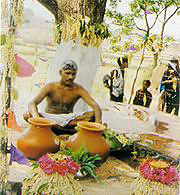 Oraon tribes are one of the biggest tribes in the whole of south Asia. Residing in large numbers in West Bengal, the Oraon tribes also reside in Delhi, Chennai, Patna, Mumbai, Bhubaneswar, Allahabad, Bhopal, Hyderabad, Lucknow, Jharkhand, Orissa, Bihar and some parts of Chhattisgarh. Oraon tribe is a significant Dravidian tribe of Chota Nagpur Plateau. The history of Oraon tribes bears the evidence that these tribes have originally migrated from Maharashtra. The tribal folk lore, songs and tales say that they stayed in Rohtasgarh for a long time. These Oraon tribes converse with each other in Kurukh language, a popular language belonging to the Dravidian language family. Due to their amiable nature, these Oraon tribes live in close association with their adjoining tribes like Munda tribe. In fact the chief of the Oraon tribes is called as Munda.
Oraon tribes are one of the biggest tribes in the whole of south Asia. Residing in large numbers in West Bengal, the Oraon tribes also reside in Delhi, Chennai, Patna, Mumbai, Bhubaneswar, Allahabad, Bhopal, Hyderabad, Lucknow, Jharkhand, Orissa, Bihar and some parts of Chhattisgarh. Oraon tribe is a significant Dravidian tribe of Chota Nagpur Plateau. The history of Oraon tribes bears the evidence that these tribes have originally migrated from Maharashtra. The tribal folk lore, songs and tales say that they stayed in Rohtasgarh for a long time. These Oraon tribes converse with each other in Kurukh language, a popular language belonging to the Dravidian language family. Due to their amiable nature, these Oraon tribes live in close association with their adjoining tribes like Munda tribe. In fact the chief of the Oraon tribes is called as Munda.
If one dissects the Oraon society, it can be segregated into several sub castes. These include Kudas (navvies) and Kisans (cultivators). Beyond this, Oraon tribes abide by the village and clan exogamy. The patrilineal extended family is the supreme residential unit, and also nuclear families are also prevalent. Traditionally, Oraons are dependent on forest and farms for their livelihood. Few members of Oraon tribal group have immigrated to the north-eastern part of the country where they are employed in the various tea estates.
Following the practice of several tribes of India, these Oraon tribes follow the trend of sending the youths to the dormitories. These dorms are called dhumkuria. Boys are marked on the arm before being allowed in to this establishment. They practice shifting cultivation. Although hunting profession was given due importance in this tribal community, it has become only an affair as part of the ceremonial event in later years. Moreover, nowadays, a special hunting ceremony also is feted exclusively for women folks of Oraon society. It is observed every twelve years.
Those anthropologists who have conducted surveys on Oraon tribes and its various aspects of culture and tradition, have unanimously came to the conclusion that these tribes are religious minded mostly following the customs of Hinduism. What is interesting to note that nowhere else in India these deities are being worshipped. Only a small section of people, near about twenty five percent, follow Christianity. The culture of Oraon tribe comprises a wide range of folk songs, traditional musical instruments, dances and tales. Both male and female members of the tribal group participate in dance forms that are performed at social festivals and other events.
















